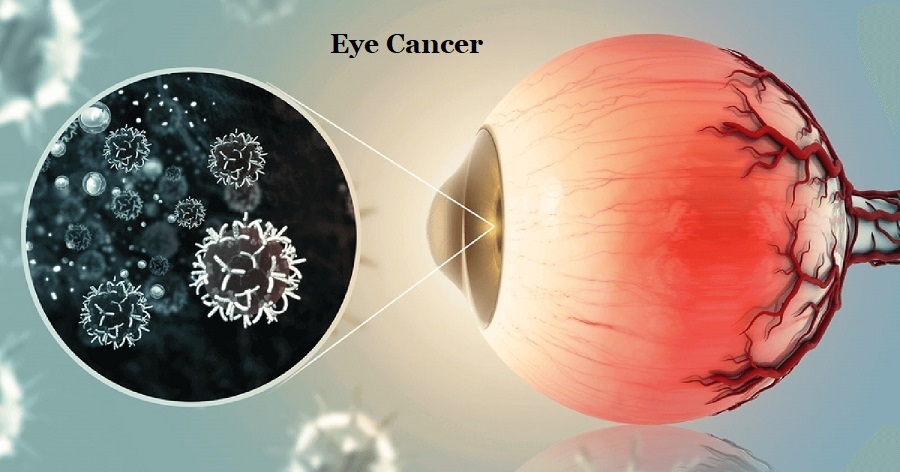What is Eye Cancer?
Eye cancer is a general term used to describe many types of tumors that can begin in various parts of the eye. It occurs when healthy cells in or around the eye change and grow uncontrollably, forming a mass called a tumor.
A tumor can be benign or cancerous. A benign tumor means that the tumor may grow but will not spread. Ninety percent of tumor tissues that occur in the eye develop benignly, and it should be known that these tissues do not cause eye cancer.
A cancerous tumor is malignant, meaning it can grow and spread to other parts of the body. Eye cancer is rare. It can affect the outer parts of the eye, such as the eyelid, which consists of muscle, skin and nerves. If cancer starts inside the eyeball, it is called intraocular cancer.
What are The Causes of Eye Cancer?
Although the exact cause of eye cancer is unknown, certain risk factors may play a role in the development of this cancer.
These risk factors include:
-
Genetic Factors:
Some familial genetic diseases have been linked to the development of eye cancer. These diseases include von Hippel-Lindau disease and retinoblastoma.
-
Ultraviolet (UV) Rays:
Exposure to UV rays, especially in childhood and adolescence, may increase the risk of eye cancer.
-
Exposure to Radiation:
It may increase the risk of eye cancer, especially in the head and neck area.
-
Immune System Problems:
Some immune system problems may increase the risk of eye cancer. These include HIV and post-transplant immunosuppression.
-
Age:
Eye cancer can occur at any age, but it usually occurs in children and older adults.
-
Other Factors:
Other factors, such as exposure to certain chemicals, smoking, and dietary habits, may also increase the risk of eye cancer.
Having a risk factor for developing eye cancer does not mean you will develop this cancer. But reducing risk factors may reduce the risk of eye cancer.
What are The Symptoms of Eye Cancer?
Symptoms of eye cancer may vary depending on the type of cancer and the extent to which it has spread.
But some common symptoms are:
-
Swelling, Puffiness and Swelling in or Around the Eye:
Eye cancer can occur when abnormal cells grow in the eyeball or around the eye. This can lead to swelling or blistering.
-
Eye Vision Changes or Blurred Vision:
It may cause problems with vision. Vision may become blurred or altered.
-
Eye Color Changes or Difference in Eye Color:
Especially in case of iris cancer (Iris Melanoma), changes in eye color may occur.
-
Feeling of Stinging, Pain or Discomfort in the Eye:
Eye discomfort or pain may be common in people with eye cancer.
-
Sensation of Foreign Body in Eye or Constant Tearing:
The feeling of a foreign body in the eye or constant tearing may also be among the symptoms of eye cancer.
What are The Types of Eye Cancer?
Eye cancer can develop around the eye, in the eyelids, in the structures inside the eye, in the iris, in the retina and the connective tissue under the retina, in the vascular layer called the choroid, and in the region between the eye bones and the eye called the orbit. And it is divided into types according to the region where it develops.
The most common types of eye cancer are:
-
Eye Melanoma:
The middle layer of the eye is called the uvea and includes the iris at the front of the eye, the ciliary body, and the choroid at the back of the eye. Cancer begins when the pigment-producing melanocyte cells in this layer become abnormal and is the most common type of eye cancer in adults.
-
Eye Lymphoma:
It is lymphoma that begins in the eyeball, and most are non-Hodgkin lymphoma. Retinoblastoma: It is a rare type of childhood eye cancer. It develops in the retina, the light-sensitive layer of the eye.
Rare types of eye cancer are:
-
Squamous Cell Carcinoma of the Eye:
It usually starts in the conjunctiva and eyelid.
-
Basal Cell Carcinoma of the Eye:
It usually starts in the eyelid and is the most common type of cancer in this area.
-
Sebaceous Carcinoma of the Eyelid:
It is a cancer of the sebaceous (oil-producing) glands and most commonly develops in the upper eyelid near the eyelash line.
-
Adenoid Cystic Carcinoma:
It is the most common type of cancer of the tear gland.
-
Eye Pit Sarcoma:
It can start in the muscles that move the eye and mostly affects children.
Eye cancer can also develop through the spread (metastasis) of another type of cancer and these are called secondary eye cancers. The most common cancers that spread to the eye are breast and lung cancers. These cancers often spread to the uveal layer.
What are The Stages of Eye Cancer?
Eye cancers are generally staged using the TDM system.
According to this:
-
T (Tumor):
It is graded 1-4 depending on tumor size. The tumor is 1 at the smallest level and 4 at the largest level.
-
N (Lymph Node):
It is graded from 0 to 1, depending on whether the cancer has spread to nearby lymph nodes.
-
M (Metastasis):
It is graded from 0 to 1, depending on whether the cancer has spread to another part of the body.
How is Eye Cancer Diagnosed?
-
Ophthalmoscope:
It is a tool that illuminates and shows the inside of the eye in detail, including the retina and optic nerve. It is done in two ways.
In direct ophthalmoscopy, the instrument is brought closer to the patient and the fundus of the eye is seen as large and flat.
In indirect ophthalmoscopy, light is shined on the patient’s eye with the help of special lenses and the inverted and small image of the fundus is examined.
-
Biomicroscope:
It is a type of microscope that uses a powerful beam of light to examine the inside of the eye.
-
Gonioscopy (Angle Examination):
It is a special lens that is placed directly between the eyelids to look for tumor growth in difficult-to-see eye areas. The eye is anesthetized before the examination.
-
Optomap Retinal Scanning:
It is a digital scanning system that images most of the retina.
-
Optical Coherence Tomography:
It is an imaging test that uses light waves to take cross-sectional images of the retina, choroid, and sclera.
-
Tonometer:
It is an instrument used to measure intraocular pressure. The patient is laid on his back and a few drops of anesthetic are applied to his cornea.
The device is then placed on the cornea and the intraocular pressure is read from the indicator.
Eye drops may be used to dilate pupils before an eye exam. This helps the doctor see the structures inside the eye better.
Driving should not be done after the appointment as the medication used may cause vision problems for a few hours.
-
Complete Blood Count (Hemogram):
This blood test measures the number and quality of white and red blood cells and platelets. It is done for general health check.
Imaging Tests
-
Ultrasound:
An eye ultrasound uses a small wand-like instrument (ultrasound probe). It is placed on closed eyelids or directly on the surface of the eye. Sometimes the eye may be anesthetized before the ultrasound. It is often very helpful in diagnosing eye melanoma. It can also show the location and size of the tumor. Ultrasound biomicroscopy is a special type of ultrasound that uses higher frequency sound waves to image the front parts of the eye.
-
Eye Angiography:
It is an angiography procedure performed to examine the vessels inside the eye and is performed by injecting a medicated orange dye into the arm or groin. As the dye moves through the body and into the blood vessels behind the eye, imaging is performed with a special camera.
-
Biopsy:
In an eye biopsy, part or all of the suspicious area may be removed. But it is not preferred unless necessary because it may be difficult to obtain a cancerous tissue sample without damaging the eye or spreading the cancer.
Additionally, some cancers can only be diagnosed with an eye exam or imaging test. It is generally used if the diagnosis cannot be made with other tests or if the patient will be subjected to a cytogenetic test (which shows structural disorders).
Biopsy is usually done by fine needle aspiration. This procedure uses a very thin needle to remove a small sample of cells from an abnormal area of the eye.
When diagnosing eye lymphoma, vitrectomy is performed and uses very small instruments to remove some of the jelly-like fluid inside the eye through several small incisions.
-
Cytogenetics and Gene Profiling:
These two tests may be done to gather more information about the patient’s chances of recovery and treatment options. Cytogenetics is the analysis of a cell’s chromosomes (DNA strands), including the number, size, shape, and arrangement of chromosomes. Gene profiling is a test that identifies specific genes, proteins and other tumor-specific factors. These tests are done using a tissue sample removed during a biopsy or surgery.
He or she may order other tests to see if the eye cancer has spread to other parts of the body.
Relevant tests may include:
- Blood Tests to Measure Liver Function
- Chest X-Ray
- Computed Tomography (CT) Scan
- Magnetic Resonance Imaging (MRI) Scan
- Abdominal Ultrasound
- Positron Emission Tomography (PET) Scan
What are The Treatment Options for Eye Cancer?
Once an eye cancer diagnosis is made, the doctor will discuss the best options for treatment.
The most appropriate treatment options for eye cancer depend on these factors:
- Cancer Type
- Location and Size of Cancer
- Whether Cancer Has Spread to Other Regions (Metastasis)
- Patient’s Age and General Health Condition
Treatments for eye cancer are as follows:
Radiation Therapy:
Radiation therapy, in particular, uses high-powered energy such as protons or gamma rays to kill cancer cells. This radiation therapy is typically used for small to medium-sized Eye Melanomas.
Radiation is usually delivered to the tumor by placing a radioactive plate in your eye directly over the tumor in a procedure called Brachytherapy.
The plate is then held in place with temporary stitches. The plate to be placed on your eye resembles a bottle cap and contains low radioactive particles. Ultimately, the plate stays in place for four to five days before being removed.
Surgical Intervention:
Surgery is another commonly used treatment method for eye cancer. Depending on the stage and size of the tumor, one of the following types of surgery may be performed.
Radiation may also come from a machine that directs radiation, such as proton beams, into your eye (external beam radiation or teletherapy). This type of radiation therapy is usually administered over several days.
-
Eye Resection:
The tumor and a small amount of healthy tissue around the tumor are removed.
-
Enucleation:
It is a surgical intervention in which the eye is removed. It can be applied in some advanced eye cancer cases.
-
Orbital Exenteration:
It is a surgery in which the eye, eyelids, muscle, fat and nerve tissues in the eye socket are removed. It can only be used in very aggressive or recurrent eye cancers.
-
Mohs Micrographic Surgery:
The tumor is removed in layers. Each layer is examined in the laboratory until no cancer cells are seen. Mohs surgery is sometimes used to treat a tumor in the eyelid or conjunctiva.
-
Cryosurgery:
It uses a controlled freezing process to freeze and destroy tissue. Sometimes it can be applied to treat tumors in the conjunctiva or eyelid.
-
Laser Surgery:
It is sometimes used to destroy small tumors in the eye.
-
Plastic Surgery:
It is applied to ensure normal movement of the eye and to correct deformities (outer appearance) after surgeries such as eye resection.
-
Chemotherapy:
Chemotherapy is a method of treating eye cancer using chemical drugs. It may be injected directly into the eye area (intraocular), into the cerebrospinal fluid (intrathecal), or given through an IV. Chemotherapy may be given to patients with retinoblastoma or intraocular lymphoma.
-
Targeted Therapy:
This treatment uses drugs to target specific molecules (such as proteins) on or within cancer cells to stop the growth and spread of cancer. Drugs used to treat eye cancer are rituximab, ibritumomab, bevacizumab, ranibizumab, imatinib and sorafenib.
-
Immunotherapy:
Immunotherapy uses the immune system to help destroy cancer cells. Interferon alpha-2b may sometimes be used to treat eyelid or eye lymphoma tumor.
What are The Complications of Eye Cancer?
Eye cancer can cause serious complications if left untreated.
These may include:
-
Eye Loss:
Eye cancer can impair the function of the eye and cause vision loss. If left untreated, eye loss may be inevitable.
-
Spread of Cancer:
When eye cancer is left untreated, cancer cells can spread to other parts of the body. Eye cancer can spread, especially to the lungs and liver.
-
Infection:
Eye cancer treatment may increase the risk of infection. Surgery or radiation therapy can weaken the body’s immune system, increasing the risk of infection.
-
Disruption of Eye Movements:
Eye cancer can cause impaired eye movements when the eye muscles or nerves are affected.
-
Aesthetic Changes:
Eye cancer treatment may cause changes in the shape and appearance of the eyelids or eye. In some cases, plastic surgery may be required.
Early diagnosis and treatment of eye cancer can help prevent or alleviate these complications. Therefore, when symptoms of eye cancer are noticed, a doctor should be consulted and appropriate treatment methods should be discussed.






